CRUD (Create, Read, Update and Delete) application is the most important application for creating any project. It provides an idea to develop a large project. In spring MVC, we can develop a simple CRUD application.
Here, we are using JdbcTemplate for database interaction.
Create a table
Here, we are using emp99 table present in the MySQL database. It has 4 fields: id, name, salary, and designation. Here, id is auto incremented which is generated by the sequence.

Spring MVC CRUD Example
1. Add dependencies to pom.xml file.
pom.xml
- <!-- https://mvnrepository.com/artifact/org.springframework/spring-webmvc -->
- <dependency>
- <groupId>org.springframework</groupId>
- <artifactId>spring-webmvc</artifactId>
- <version>5.1.1.RELEASE</version>
- </dependency>
- <!-- https://mvnrepository.com/artifact/org.apache.tomcat/tomcat-jasper -->
- <dependency>
- <groupId>org.apache.tomcat</groupId>
- <artifactId>tomcat-jasper</artifactId>
- <version>9.0.12</version>
- </dependency>
- <!-- https://mvnrepository.com/artifact/javax.servlet/javax.servlet-api -->
- <dependency>
- <groupId>javax.servlet</groupId>
- <artifactId>servlet-api</artifactId>
- <version>3.0-alpha-1</version>
- </dependency>
- <!-- https://mvnrepository.com/artifact/javax.servlet/jstl -->
- <dependency>
- <groupId>javax.servlet</groupId>
- <artifactId>jstl</artifactId>
- <version>1.2</version>
- </dependency>
- <!-- https://mvnrepository.com/artifact/mysql/mysql-connector-java -->
- <dependency>
- <groupId>mysql</groupId>
- <artifactId>mysql-connector-java</artifactId>
- <version>8.0.11</version>
- </dependency>
- <!-- https://mvnrepository.com/artifact/org.springframework/spring-jdbc -->
- <dependency>
- <groupId>org.springframework</groupId>
- <artifactId>spring-jdbc</artifactId>
- <version>5.1.1.RELEASE</version>
- </dependency>
2. Create the bean class
Here, the bean class contains the variables (along setter and getter methods) corresponding to the fields exist in the database.
Emp.java
- package com.javatpoint.beans;
- public class Emp {
- private int id;
- private String name;
- private float salary;
- private String designation;
- public int getId() {
- return id;
- }
- public void setId(int id) {
- this.id = id;
- }
- public String getName() {
- return name;
- }
- public void setName(String name) {
- this.name = name;
- }
- public float getSalary() {
- return salary;
- }
- public void setSalary(float salary) {
- this.salary = salary;
- }
- public String getDesignation() {
- return designation;
- }
- public void setDesignation(String designation) {
- this.designation = designation;
- }
- }
3. Create the controller class
EmpController.java
- package com.javatpoint.controllers;
- import java.util.List;
- import org.springframework.beans.factory.annotation.Autowired;
- import org.springframework.stereotype.Controller;
- import org.springframework.ui.Model;
- import org.springframework.web.bind.annotation.ModelAttribute;
- import org.springframework.web.bind.annotation.PathVariable;
- import org.springframework.web.bind.annotation.RequestMapping;
- import org.springframework.web.bind.annotation.RequestMethod;
- import com.javatpoint.beans.Emp;
- import com.javatpoint.dao.EmpDao;
- @Controller
- public class EmpController {
- @Autowired
- EmpDao dao;//will inject dao from XML file
- /*It displays a form to input data, here "command" is a reserved request attribute
- *which is used to display object data into form
- */
- @RequestMapping("/empform")
- public String showform(Model m){
- m.addAttribute("command", new Emp());
- return "empform";
- }
- /*It saves object into database. The @ModelAttribute puts request data
- * into model object. You need to mention RequestMethod.POST method
- * because default request is GET*/
- @RequestMapping(value="/save",method = RequestMethod.POST)
- public String save(@ModelAttribute("emp") Emp emp){
- dao.save(emp);
- return "redirect:/viewemp";//will redirect to viewemp request mapping
- }
- /* It provides list of employees in model object */
- @RequestMapping("/viewemp")
- public String viewemp(Model m){
- List<Emp> list=dao.getEmployees();
- m.addAttribute("list",list);
- return "viewemp";
- }
- /* It displays object data into form for the given id.
- * The @PathVariable puts URL data into variable.*/
- @RequestMapping(value="/editemp/{id}")
- public String edit(@PathVariable int id, Model m){
- Emp emp=dao.getEmpById(id);
- m.addAttribute("command",emp);
- return "empeditform";
- }
- /* It updates model object. */
- @RequestMapping(value="/editsave",method = RequestMethod.POST)
- public String editsave(@ModelAttribute("emp") Emp emp){
- dao.update(emp);
- return "redirect:/viewemp";
- }
- /* It deletes record for the given id in URL and redirects to /viewemp */
- @RequestMapping(value="/deleteemp/{id}",method = RequestMethod.GET)
- public String delete(@PathVariable int id){
- dao.delete(id);
- return "redirect:/viewemp";
- }
- }
4. Create the DAO class
Let's create a DAO class to access the required data from the database.
EmpDao.java
- package com.javatpoint.dao;
- import java.sql.ResultSet;
- import java.sql.SQLException;
- import java.util.List;
- import org.springframework.jdbc.core.BeanPropertyRowMapper;
- import org.springframework.jdbc.core.JdbcTemplate;
- import org.springframework.jdbc.core.RowMapper;
- import com.javatpoint.beans.Emp;
- public class EmpDao {
- JdbcTemplate template;
- public void setTemplate(JdbcTemplate template) {
- this.template = template;
- }
- public int save(Emp p){
- String sql="insert into Emp99(name,salary,designation) values('"+p.getName()+"',"+p.getSalary()+",'"+p.getDesignation()+"')";
- return template.update(sql);
- }
- public int update(Emp p){
- String sql="update Emp99 set name='"+p.getName()+"', salary="+p.getSalary()+",designation='"+p.getDesignation()+"' where id="+p.getId()+"";
- return template.update(sql);
- }
- public int delete(int id){
- String sql="delete from Emp99 where id="+id+"";
- return template.update(sql);
- }
- public Emp getEmpById(int id){
- String sql="select * from Emp99 where id=?";
- return template.queryForObject(sql, new Object[]{id},new BeanPropertyRowMapper<Emp>(Emp.class));
- }
- public List<Emp> getEmployees(){
- return template.query("select * from Emp99",new RowMapper<Emp>(){
- public Emp mapRow(ResultSet rs, int row) throws SQLException {
- Emp e=new Emp();
- e.setId(rs.getInt(1));
- e.setName(rs.getString(2));
- e.setSalary(rs.getFloat(3));
- e.setDesignation(rs.getString(4));
- return e;
- }
- });
- }
- }
5. Provide the entry of controller in the web.xml file
web.xml
- <?xml version="1.0" encoding="UTF-8"?>
- <web-app xmlns:xsi="http://www.w3.org/2001/XMLSchema-instance" xmlns="http://java.sun.com/xml/ns/javaee" xsi:schemaLocation="http://java.sun.com/xml/ns/javaee http://java.sun.com/xml/ns/javaee/web-app_3_0.xsd" id="WebApp_ID" version="3.0">
- <display-name>SpringMVC</display-name>
- <servlet>
- <servlet-name>spring</servlet-name>
- <servlet-class>org.springframework.web.servlet.DispatcherServlet</servlet-class>
- <load-on-startup>1</load-on-startup>
- </servlet>
- <servlet-mapping>
- <servlet-name>spring</servlet-name>
- <url-pattern>/</url-pattern>
- </servlet-mapping>
- </web-app>
6. Define the bean in the xml file
spring-servlet.xml
- <?xml version="1.0" encoding="UTF-8"?>
- <beans xmlns="http://www.springframework.org/schema/beans"
- xmlns:xsi="http://www.w3.org/2001/XMLSchema-instance"
- xmlns:context="http://www.springframework.org/schema/context"
- xmlns:mvc="http://www.springframework.org/schema/mvc"
- xsi:schemaLocation="
- http://www.springframework.org/schema/beans
- http://www.springframework.org/schema/beans/spring-beans.xsd
- http://www.springframework.org/schema/context
- http://www.springframework.org/schema/context/spring-context.xsd
- http://www.springframework.org/schema/mvc
- http://www.springframework.org/schema/mvc/spring-mvc.xsd">
- <context:component-scan base-package="com.javatpoint.controllers"></context:component-scan>
- <bean class="org.springframework.web.servlet.view.InternalResourceViewResolver">
- <property name="prefix" value="/WEB-INF/jsp/"></property>
- <property name="suffix" value=".jsp"></property>
- </bean>
- <bean id="ds" class="org.springframework.jdbc.datasource.DriverManagerDataSource">
- <property name="driverClassName" value="com.mysql.jdbc.Driver"></property>
- <property name="url" value="jdbc:mysql://localhost:3306/test"></property>
- <property name="username" value=""></property>
- <property name="password" value=""></property>
- </bean>
- <bean id="jt" class="org.springframework.jdbc.core.JdbcTemplate">
- <property name="dataSource" ref="ds"></property>
- </bean>
- <bean id="dao" class="com.javatpoint.dao.EmpDao">
- <property name="template" ref="jt"></property>
- </bean>
- </beans>
7. Create the requested page
index.jsp
8. Create the other view components
empform.jsp
- <%@ taglib uri="http://www.springframework.org/tags/form" prefix="form"%>
- <%@ taglib uri="http://java.sun.com/jsp/jstl/core" prefix="c"%>
- <h1>Add New Employee</h1>
- <form:form method="post" action="save">
- <table >
- <tr>
- <td>Name : </td>
- <td><form:input path="name" /></td>
- </tr>
- <tr>
- <td>Salary :</td>
- <td><form:input path="salary" /></td>
- </tr>
- <tr>
- <td>Designation :</td>
- <td><form:input path="designation" /></td>
- </tr>
- <tr>
- <td> </td>
- <td><input type="submit" value="Save" /></td>
- </tr>
- </table>
- </form:form>
empeditform.jsp
Here "/SpringMVCCRUDSimple" is the project name, change this if you have different project name. For live application, you can provide full URL.
- <%@ taglib uri="http://www.springframework.org/tags/form" prefix="form"%>
- <%@ taglib uri="http://java.sun.com/jsp/jstl/core" prefix="c"%>
- <h1>Edit Employee</h1>
- <form:form method="POST" action="/SpringMVCCRUDSimple/editsave">
- <table >
- <tr>
- <td></td>
- <td><form:hidden path="id" /></td>
- </tr>
- <tr>
- <td>Name : </td>
- <td><form:input path="name" /></td>
- </tr>
- <tr>
- <td>Salary :</td>
- <td><form:input path="salary" /></td>
- </tr>
- <tr>
- <td>Designation :</td>
- <td><form:input path="designation" /></td>
- </tr>
- <tr>
- <td> </td>
- <td><input type="submit" value="Edit Save" /></td>
- </tr>
- </table>
- </form:form>
viewemp.jsp
- <%@ taglib uri="http://www.springframework.org/tags/form" prefix="form"%>
- <%@ taglib uri="http://java.sun.com/jsp/jstl/core" prefix="c"%>
- <h1>Employees List</h1>
- <table border="2" width="70%" cellpadding="2">
- <tr><th>Id</th><th>Name</th><th>Salary</th><th>Designation</th><th>Edit</th><th>Delete</th></tr>
- <c:forEach var="emp" items="${list}">
- <tr>
- <td>${emp.id}</td>
- <td>${emp.name}</td>
- <td>${emp.salary}</td>
- <td>${emp.designation}</td>
- <td><a href="editemp/${emp.id}">Edit</a></td>
- <td><a href="deleteemp/${emp.id}">Delete</a></td>
- </tr>
- </c:forEach>
- </table>
- <br/>
- <a href="empform">Add New Employee</a>
Output:
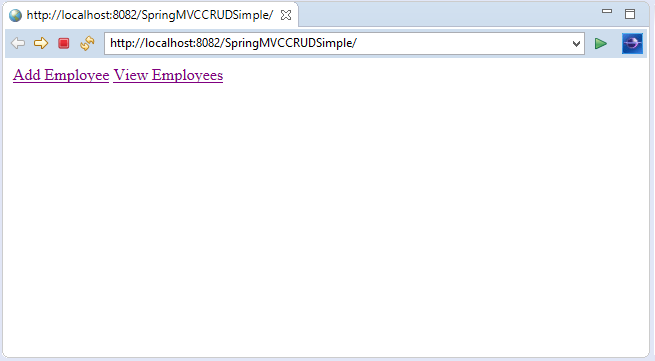
On clicking Add Employee, you will see the following form.
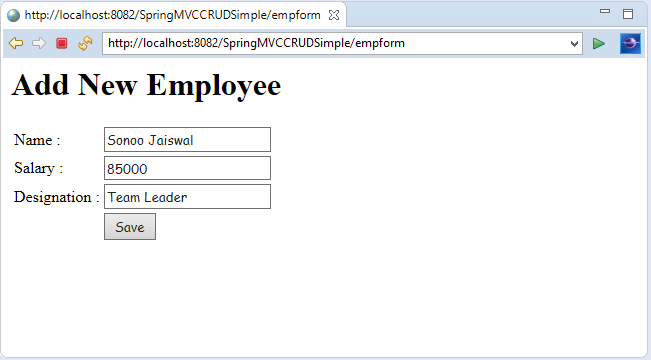
Fill the form and click Save to add the entry into the database.
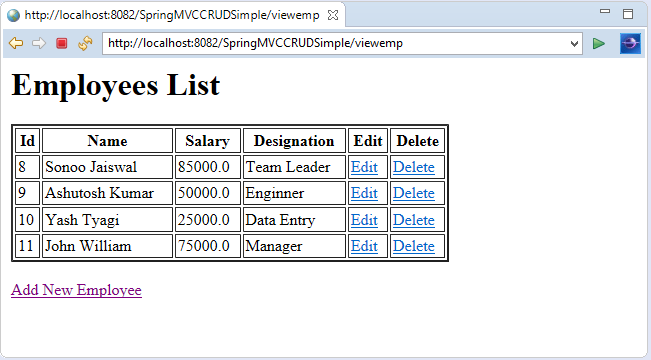
Now, click Edit to make some changes in the provided data.
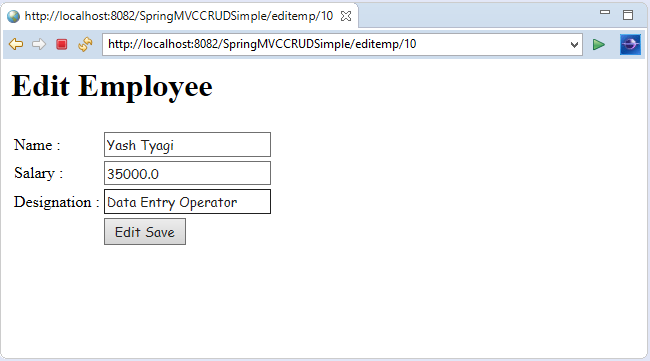
Now, click Edit Save to add the entry with changes into the database.
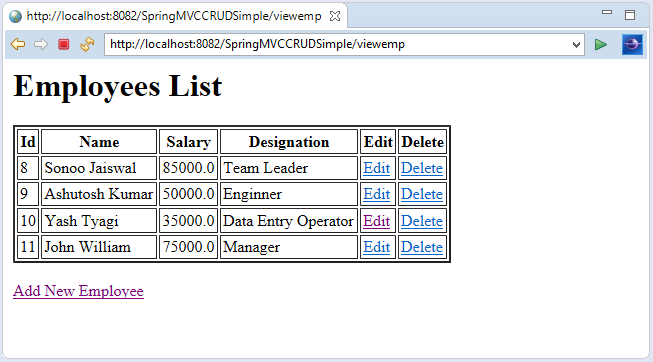
Now, click Delete to delete the entry from the database.
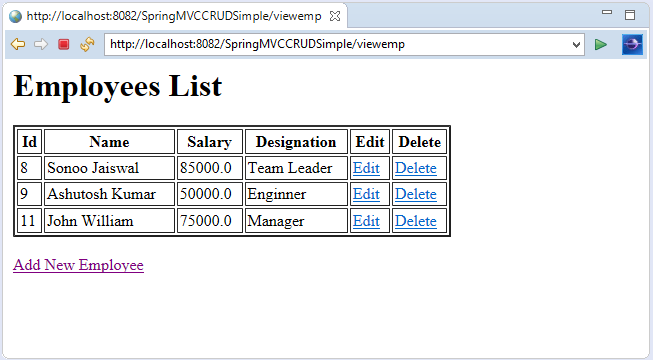
No comments:
Post a Comment